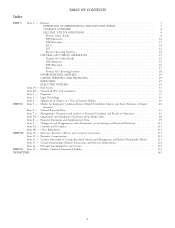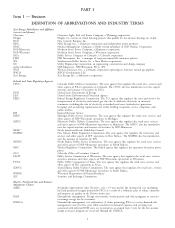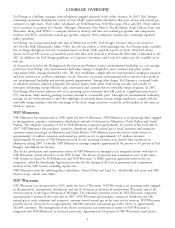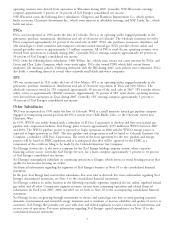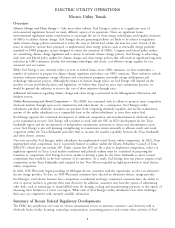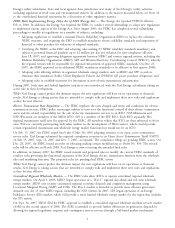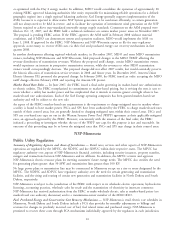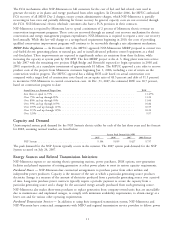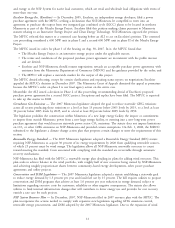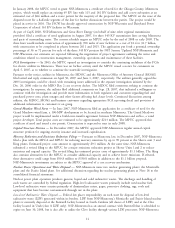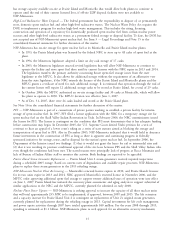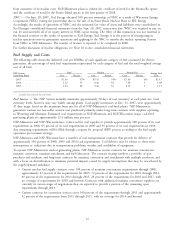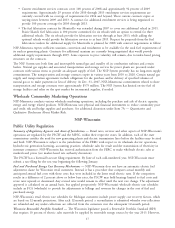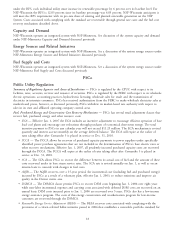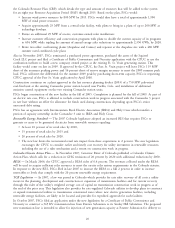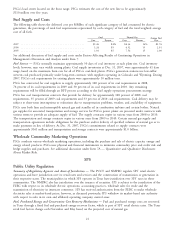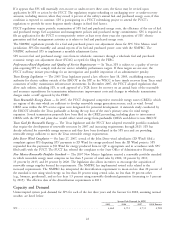Xcel Energy 2007 Annual Report Download - page 22
Download and view the complete annual report
Please find page 22 of the 2007 Xcel Energy annual report below. You can navigate through the pages in the report by either clicking on the pages listed below, or by using the keyword search tool below to find specific information within the annual report.and energy to the NSP System for native load customers, which are retail and wholesale load obligations with terms of
more than one year.
Excelsior Energy Inc. (Excelsior) — In December 2005, Excelsior, an independent energy developer, filed a power
purchase agreement with the MPUC seeking a declaration that NSP-Minnesota be compelled to enter into an
agreement to purchase the output from two integrated gas combined cycle (IGCC) plants to be located in northern
Minnesota as part of the Mesaba Energy Project. Excelsior filed this petition making claims pursuant to Minnesota
statutes relating to an Innovative Energy Project and Clean Energy Technology. NSP-Minnesota opposed the petition.
The MPUC referred this matter to a contested case hearing before an ALJ to act on Excelsior’s petition. The contested
case proceeding considered a 600 MW unit in phase I and a second 600 MW unit in phase II of the Mesaba Energy
Project.
The MPUC issued its order for phase 1 of the hearing on Aug. 30, 2007. In it, the MPUC found that:
• The Mesaba Energy Project is an innovative energy project under the applicable statute;
• The terms and conditions of the proposed purchase power agreement are inconsistent with the public interest
and are denied;
• Excelsior and NSP-Minnesota should resume negotiations towards an acceptable purchase power agreement, with
assistance from the Minnesota Department of Commerce (MDOC) and the guidance provided by the order; and
• The MPUC will explore a statewide market for the output of this project.
The MPUC denied rehearing, except for certain clarifications and requiring status reports on negotiations Excelsior
appealed the MPUC’s decision in December 2007. The Minnesota Court of Appeals dismissed the appeal as premature
because the MPUC’s order on phase I is not final agency action on the entire case.
Meanwhile, the ALJ issued a decision in Phase 2 of this proceeding, recommending denial of Excelsior’s proposed
purchase power agreement for a second IGCC project. Exceptions and replies have been filed. The MPUC is expected
to take up this matter in 2008.
Greenhouse Gas Emissions — The 2007 Minnesota legislature adopted the goal to reduce statewide GHG emissions
across all sectors producing those emissions to a level at least 15 percent below 2005 levels by 2015, to a level at least
30 percent below 2005 levels by 2025, and to a level at least 80 percent below 2005 levels by 2050.
The legislation prohibits the construction within Minnesota of a new large energy facility, the import or commitment
to import from outside Minnesota power from a new large energy facility, or entering into a new long-term power
purchase agreement that would increase statewide power sector CO2 emissions. The statute does not impose limitations
on CO2 or other GHG emissions on NSP-Minnesota and provided certain exemptions. On Feb. 1, 2008, the MDOC
submitted to the legislature a climate change action plan that proposes certain changes to meet the requirements of this
section.
Renewable Energy Standard — The 2007 Minnesota legislature adopted a Renewable Energy Standard (RES) statute
requiring NSP-Minnesota to acquire 30 percent of its energy requirements by 2020 from qualifying renewable sources,
of which 25 percent must be wind energy. The legislation allows all NSP-Minnesota renewable resources to count
toward meeting the standard. Costs associated with complying with the standard are recoverable through automatic
recovery mechanisms.
NSP-Minnesota has filed with the MPUC a renewable energy plan detailing its plans for adding wind resources. This
plan seeks to achieve balance in the wind portfolio, with roughly half of new resources being owned by NSP-Minnesota
and achieving roughly proportionate shares between community-based energy developments, other power purchase
agreements and utility projects.
Conservation and DSM Legislation — The 2007 Minnesota legislature adopted a statute establishing a statewide goal
to reduce energy demand by 1.5 percent per year and fossil fuel use by 15 percent. The bill requires utilities to propose
conservation and DSM programs that achieve at least 1.0 percent per year reduction in energy demand, subject to
limitations regarding excessive costs for customers, reliability or other negative consequences. The statute also allows
utilities to fund internal infrastructure changes that will contribute to lower energy use and provides for cost recovery
outside a rate case for such projects.
NSP System Resource Plan — In December, 2007, NSP-Minnesota filed its 2007 resource plan with the MPUC. The
plan incorporates the actions needed to comply with expansive new legislation regarding GHG emissions control,
renewable energy procurement, and DSM adopted by the 2007 Minnesota legislature. Due to the expansion of wind
12


